Books by Luciano Pellegrini

Saggio sulla poesia di Victor Hugo prima dell'esilio ETS V ictor Hugo fu un poeta? Decenni di dif... more Saggio sulla poesia di Victor Hugo prima dell'esilio ETS V ictor Hugo fu un poeta? Decenni di diffidenza verso la poesia romantica hanno fatto dimenticare che non solo Hugo fu un poeta, ma fu soprattutto poeta, reputato a lungo il primo fra tutti, colui che ha condizionato tutta la poesia dell'Ottocento. Questo libro esamina una parte consistente della sua abbondante poesia: il cosiddetto periodo «prima dell'esilio» (1815-1840). La prima ambizione del libro è infatti di storia letteraria. Non s'intende solo ricordare l'importanza della poesia di Hugo, ma lo si fa studiandone una fase meno valorizzata perfino dagli specialisti. Rileggere il «primo» Hugo significa infatti riaprire la questione della modernità poetica, che da decenni è posta sotto il segno di Baudelaire, e viene qui riportata alla svolta romantica. L'ulteriore ambizione del saggio è interpretativa. Esso propone una chiave di lettura utile a interpretare una serie di temi e immagini ricorrenti, ma anche i principi del linguaggio che Hugo inaugura. Tutto viene così ricondotto a una sola, multiforme e reversibile opposizione fra l'Alto e il Basso, la quale rimanda alle grandi questioni che muovono il mondo uscito dall'89, quali la legittimità di individui e istituzioni, l'esercizio dell'autorità, il diritto alla rivoluzione.
Papers by Luciano Pellegrini
in Luca Pietromarchi (ed.), Il secolo di Sade. Il piacere del Male nella letteratura dell’Ottocento, Pacini, Pisa, 2018, pp. 119-142
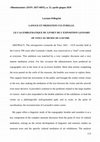
"Illuminazioni", n. 52, 2020
The retrospective Leonardo da Vinci 1452 – 1519 recently held at the Louvre 500 years after Leona... more The retrospective Leonardo da Vinci 1452 – 1519 recently held at the Louvre 500 years after Leonardo’s death, was conceived as a “total” event aimed at everyone. This ambition was matched by a very complex discourse and a very intense mediation action. For this occasion the administrators have produced an expographic text in the form of an in-octave booklet. More than merely completing the texts posted on the walls of the museum, the booklet was meant to replace them. This support freed the movements of the public and brought the reader-visitor closer to the text, thus making the mediation of the text between the visitor and the artwork even more decisive. It provided a solution to the problems related to the large number of visitors. And it also responded to the double ambition of the exhibition: to lead the visitor on a philologically well-grounded path, and to exalt, to the point of sacralization, the reconstruction of Leonardo's entire career.
My paper offers a linguistic study of the expographic booklet and considers it as a key component of the complex museum discourse from the point of view of cultural mediation, relying on the recent development of linguistic and semiotic studies on museum texts and the specific cultural mediation of art exhibitions. The analysis involves enunciative, lexical and pragmatic phenomena. The aim is to show how this verbal, portable paper support exalts the function of the expographic text putting it at the center of an exhibition project. It also shows how the mediation action was particularly crucial due to the symbolic scope of the event and the material difficulties of the visit.
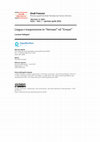
Studi Francesi
The paper compares two texts: Hugo's Hernani and Piave's libretto Ernani, based on the former for... more The paper compares two texts: Hugo's Hernani and Piave's libretto Ernani, based on the former for Verdi's music. The aim is to investigate what survives of the revolutionary aspects of the original text in the Italian language used in the libretto. Referring to his works and to Hernani as well, Hugo had claimed he had «set the language free» pushing the literary French towards the colloquial one. In spite of that, the libretto draws on the literary archaisms which characterized the coeval poetry ignoring Hugo's innovations and testifying to the "delay" of the Italian language. In the first part, the paper compares Hugo's direct expression and prosaic tension to the pretentious periphrasis and syntactic inversions of the Piave's libretto. Attention is then paid to the level of the signifier, namely to the ludic use of rhymes and phonic iterations. The close reading of the libretto reveals its internal logic and poetic dignity. More than that, comparing Hugo's virtuoso multi-layered style with the "hyperliterary" style of the libretto leads to reflect on the relationship between style and History. Feu n'exprime nécessairement l'idée d'éclat que dès qu'il s'allume. V. H. «Les écrivains ont mis la langue en liberté» afferma Victor Hugo in Réponse à un acte d'accusation (1854) 1. Retrodatando la poesia al gennaio 1834, Hugo volge lo sguardo ai primi decenni della sua carriera, al tempo delle lotte tra classici e romantici. Lo fa ammettendo la colpa di aver guidato quella che, prendendo alla lettera non senza paradossi i suoi detrattori, egli celebra come una rivoluzione delle lettere. Nel 1854, intende stabilire una continuità tra la sua azione di scrittore di allora e la sua azione politica attuale, diventato, tra il 1848 e l'ascesa al potere di Napoleone III, radicalmente repubblicano e punto di riferimento, da esule, di chi vuole la destituzione del nuovo sovrano. Hugo corregge dunque le precauzioni dei decenni precedenti: nella prefazione proprio di Hernani, egli aveva infine accettato di dare una definizione del romanticismo come «le libéralisme en littérature», ma auspicando «que le principe de liberté fasse son affaire, mais qu'il la fasse bien. Dans les lettres, comme dans la société, point d'étiquette, point d'anarchie: des lois. Ni talons rouges, ni bonnets rouges» 2. In esilio, il poeta pone senza più sfumature di sorta l'equivalenza di rivoluzione politica (compreso il Terrore) e rivoluzione linguistico-letteraria. Le storie letterarie sono solite ricomprendere quegli «scrittori» innovatori entro la prima metà del secolo, entro il 1843, quando il presunto fiasco dei Burgraves dello stesso Hugo segnerebbe per convenzione la fine del romanticismo.
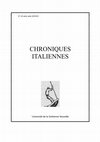
Chroniques italiennes, 2022
L’exposition monographique Léonard de Vinci. 1452-1519 tenue au Musée du Louvre (24 octobre 2019 ... more L’exposition monographique Léonard de Vinci. 1452-1519 tenue au Musée du Louvre (24 octobre 2019 – 24 février 2020) a suscité une véritable affaire diplomatique entre la France et l’Italie dont les causes s’inscrivent cependant dans la très longue durée, en remontant sinon aux guerres d’Italie, du moins aux campagnes napoléoniennes. L’affaire s’est officiellement « réglée » par un Protocole d’Entente signé à Paris le 24 septembre 2019. C’est dans ce contexte tendu que la dernière main a été mise à tous les textes expographiques et au livret in octavo – support inhabituel – disponible à l’entrée de l’exposition, comprenant les textes d’introduction à l’exposition, ceux des différentes parties constituant le parcours de l’exposition, et ceux des notices des œuvres exposées. D’où la question suivante : quel traitement l’exposition réserve-t-elle à « la terre natale du maître », qu’il n’a quittée qu’en 1516 ? De quelle manière l’institution française en assure-t-elle la médiation ? Des interrogations qui sont d’autant plus pertinentes que des « difficultés dans les négociations » ont accompagné la conception et l’organisation de l’exposition au fil des années. Pour apporter des éléments de réponse, cet article aborde le discours muséal qui participe à l’acte d’exposition et finit par construire le sens de la visite. Il s’agit en effet d’étudier une médiation dans la médiation - la médiation de ce qui touche à l’Italie, dans la médiation culturelle d’ensemble assurée par l’apparat textuel - d’un point de vue linguistique (énonciatif, lexical, pragmatique) en privilégiant deux fonctions essentielles du texte expographique qui croisent la question diplomatique : celle de la vulgarisation, qui concerne la dimension didactique de la médiation, et celle de la valorisation, tenant à la nature épidictique du texte de musée.
Revue italienne d’études françaises, 2013
Lumières et gratuité. Le thème de la retraite dans les Odes et Ballades de Hugo Revue italienne d... more Lumières et gratuité. Le thème de la retraite dans les Odes et Ballades de Hugo Revue italienne d'études françaises, 3 | 2013
Studi Francesi
Fra i suoi meriti maggiori il saggio di Pierre Popovic annovera la chiarezza. Essa non contraddis... more Fra i suoi meriti maggiori il saggio di Pierre Popovic annovera la chiarezza. Essa non contraddistingue tanto lo stile, generalmente mosso da un gergo teorizzante col quale il lettore deve necessariamente scendere a patti, quanto il tentativo di esplicitare metodo, modelli, finalita e di organizzare il discorso in categorie razionali e schemi illustrativi. Nel titolo e gia dichiarato il duplice programma del libro: una lettura dei Miserables, un esperimento di sociocritica. L’introduzione occ...
Revue italienne d’études françaises
Revue italienne d’études françaises
Double jeu
Le numero 19 de Transalpina offre un panorama du cinema italien contemporain. Il fait suite au co... more Le numero 19 de Transalpina offre un panorama du cinema italien contemporain. Il fait suite au colloque « Le cinema italien d’aujourd’hui, entre film politique et film engage » organise a l’universite de Caen Normandie a l’automne 2015 par l’equipe de recherche ERLIS EA 4254. En ouverture, Jean A. Gili pose les reperes theoriques et historiques necessaires a la bonne comprehension de ce cinema. Le lecteur trouvera ensuite des etudes monographiques consacree...
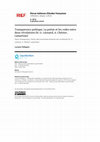
Revue italienne d’études françaises
Dans l'introduction à un volume collectif consacré à la période qui nous intéresse-Une « période ... more Dans l'introduction à un volume collectif consacré à la période qui nous intéresse-Une « période sans nom »-Les années 1780-1820 et la fabrique de l'histoire littéraire (2016)-Florence Lotterie écrit : Longtemps neutralisée par l'inscription dans la zone grise des époques « intermédiaires » entre deux temps qui comptent, la « période sans nom », selon la formule en elle-même alors polémique proposée par Simone Balayé et Jean Roussel dans un numéro fondateur de la revue Dix-Huitième Siècle titré « Au tournant des Lumières (1780-1820) », a souffert d'une indétermination historiographique la condamnant à la dilution entre un amont controversé (les Lumières) et un aval envahissant (le Romantisme) qui la réduisit longtemps au statut peu enviable de « vague lieu de passage, semi-désertique, entre deux mondes » (Balayé, Simone et Roussel, Jean, « Présentation », Dix-Huitième Siècle, n. 14, 1982, p. 6) 1. Transparence poétique. La poésie et les codes entre deux révolutions (N.-G. L...
Eighteenth-Century Fiction
Rivista Di Letterature Moderne E Comparate, 2013
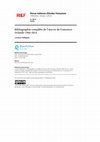
Revue Italienne D Etudes Francaises Litterature Langue Culture, Dec 15, 2014
(1934-2010), élève de Tomasi di Lampedusa, a été un des plus réputés spécialistes italiens de la ... more (1934-2010), élève de Tomasi di Lampedusa, a été un des plus réputés spécialistes italiens de la littérature française et surtout un théoricien de la littérature dont les travaux, traduits en français et en anglais, se sont signalés pour leur originalité et leur rigueur. Il est en particulier l'auteur d'un cycle de quatre volumes (Einaudi) où il présente sa théorie freudienne de la littérature ; d'un essai où il étudie les objets désuets dans l'imagination littéraire (Einaudi, Yale University Press et Classiques Garnier) ; d'une interprétation du Guépard de Lampedusa (Einaudi et Garnier) ; du roman La doppia seduzione (Einaudi). Cette bibliographie contient le répertoire complet des mononographies, articles, préfaces, mémoires et ouvrages de fiction de Francesco Orlando, publiés pendant sa vie et posthumes, ainsi qu'une sélection d'entretiens et articles de presse. Pour un inventaire exhaustif des interventions journalistiques et des entretiens écrits, audio ou
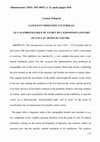
"Illuminazioni", n. 52, p. 113-141, 2020
The retrospective Leonardo da Vinci 1452-1519 recently held at the Louvre 500 years after Leonard... more The retrospective Leonardo da Vinci 1452-1519 recently held at the Louvre 500 years after Leonardo's death, was conceived as a "total" event aimed at everyone. This ambition was matched by a very complex discourse and a very intense mediation action. For this occasion the administrators have produced an expographic text in the form of an in-octave booklet. More than merely completing the texts posted on the walls of the museum, the booklet was meant to replace them. This support freed the movements of the public and brought the reader-visitor closer to the text, thus making the mediation of the text between the visitor and the artwork even more decisive. It provided a solution to the problems related to the large number of visitors. And it also responded to the double ambition of the exhibition: to lead the visitor on a philologically well-grounded path, and to exalt, to the point of sacralization, the reconstruction of Leonardo's entire career. My paper offers a linguistic study of the expographic booklet and considers it as a key component of the complex museum discourse from the point of view of cultural mediation, relying on the recent development of linguistic and semiotic studies on museum texts and the specific cultural mediation of art exhibitions. The analysis involves enunciative, lexical and pragmatic phenomena. The aim is to show how this verbal, portable paper support exalts the function of the expographic text putting it at the center of an exhibition project. It also shows how the mediation action was particularly crucial due to the symbolic scope of the event and the material difficulties of the visit.
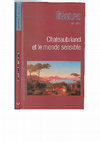
Littératures, 79 / 2018, Chateaubriand et le monde sensible, sous la dir. de P. Glaudes, A. Patierno, J.-M. Roulin, V. Sperti, 2019
Dans les Natchez, l’ailleurs se présente comme une succession de rituels exotiques. L’écriture es... more Dans les Natchez, l’ailleurs se présente comme une succession de rituels exotiques. L’écriture est également affectée par une sorte de ritualité, celle des conventions classiques – épithètes épiques, nobles périphrases, allégories chrétiennes et comparaisons mythologiques – qui parsèment la prose novatrice du roman. L’étude du thème de la ritualité indienne dans les Natchez permet ici de fonder une interprétation du style et de la poétique hybrides du roman. Une ritualité négative, celle par exemple des assemblées, qui sert les passions et l’abus politique, renvoie à la corruption de la communauté idéale. Elle s’oppose à des formes de ritualité informelle et sensible, solitaire ou en petit comité, qui témoignent de la volonté, illusoire, de se soustraire au courant de l’histoire : la sensibilité et la mentalité primitives rencontrent alors les traditions mythologique et chrétienne, cette rencontre donnant lieu à une ritualité spontanée, pétrie de tradition sans pour autant être figée. Lui aussi chargé de conventions antiques, et d’échos à la fois bibliques et mythiques, le style de l’auteur légitime une forme de mentalité primitive et analogique ne correspondant plus à aucun rite établi

in P. Gallo (éd.), (Re)lire "les Incas" de Jean-François Marmontel, Clermont-Ferrand, Presses Universitaires Blaise Pascal, coll. "Révolutions et Romantismes", n° 23, 2019
Le sujet et la visée philosophique de Les Incas, ou la destruction de l’Empire du Pérou posent d’... more Le sujet et la visée philosophique de Les Incas, ou la destruction de l’Empire du Pérou posent d’emblée la question de son rapport avec la tradition de l’utopie, sachant que Marmontel fait de l’hybridation des genres littéraires le trait formel saillant de son ouvrage. Nous montrerons que deux modèles d’écriture politique s’y affrontent : l’un renvoyant à la tradition de l’utopie radicale, l’autre poursuivant une utopie se voulant plus pragmatique. Cet affrontement encadre l’interprétation politique de l’Ailleurs américain, et il renvoie aux tensions entre utopie et réforme qui parcourent la pensée des Lumières. Le jeu de miroirs entre l’ici et l’ailleurs, nous et l’autre, se révèle complexe et ambivalent en dépit du militantisme de l’auteur. L’étude de la dialectique permet de montrer comment la trame romanesque brouille ce que le militantisme établit, jusqu’à mettre en cause l’idée d’universalisme si chère aux Lumières.
The subject and the philosophical aim of Les Incas, ou la destruction de l’Empire du Pérou raise the question of its relationship with the tradition of utopia, knowing that Marmontel insisted on the hybridization of literary genres in this book. We will show that two models of political writing face each other: one referring to the tradition of radical utopia, the other pursuing an utopia which aims to be more pragmatic. This tension determines the political interpretation of the American Elsewhere, and refers to the tensions between utopia and reform, present in Enlightenment’s theories. The links between here and elsewhere, us and the other, are complex and ambivalent despite the engagement of the author. The study of this dialectics shows how the fiction discusses what engagement establishes, even to question the idea of universalism of Reason.
in P. Gallo, (Re)lire "Les Incas" de Jean-François Marmontel, études réunies et présentées par Pierino Gallo, Clermont-Ferrand, Presses Universitaires Blaise Pascal, coll. "Révolutions et Romantismes", n° 23, 2019, p. 167-186.
http://pubp.univ-bpclermont.fr/public/Fiche_produit.php?titre=Relire%20Les%20Incas%20de%20Jean-Fran%C3%A7ois%20Marmontel
Table des matières
Remerciements
Pierino GALLO, Introduction
Partie 1 Filiations, sources, réécritures
Monique DELHOUME-SANCIAUD
L’arroseur arrosé. Pré-lectures et plagiat : deux notes des Incas
Magali FOURGNAUD
La visée morale des Incas : Marmontel et l’héritage fénelonien
Partie 2 Approches poétiques et stylistiques
James M. KAPLAN
À propos de la genèse des Incas : le manuscrit de Stockholm
Sophie LEFAY
Les Incas à la lumière des écrits théoriques et critiques de Marmontel
Pierino GALLO
Auctor in fabula : interventions auctoriales et « écriture engagée » dans Les Incas de Marmontel
Susanne GREILICH
Éclairer en divertissant : Les Incas entre œuvre philosophique et lecture facile
Partie 3 La civilisation inca en question
Françoise LE BORGNE
Les « sauvages » dans Les Incas de Marmontel : enjeux d’une catégorie caduque
Paul PELCKMANS
Les Incas devant la mort
Luciano PELLEGRINI
Aux limites de l’Empire du Soleil. Les Incas de Marmontel entre réforme et utopie
María José VILLAVERDE
L’idéal de colonisation et la leyenda negra dans Les Incas de Marmontel
Partie 4 Prolongements
Peggy DAVIS
La catastrophe empêchée, ou (re)lire Les Incas à travers l’iconographie des éléments déchaînés
Paul STROHMAIER
La lente érosion des Lumières, ou la fortune européenne des Incas
Bibliographie
Index nominum
Les auteurs
in Hugo sous les feux de la rampe – Relire “Hernani” et “Ruy Blas”, éd. A. Laster et B. Marchal, Presses de l’Université Paris-Sorbonne, Paris 2009 (p. 207-226)

Uploads
Books by Luciano Pellegrini
Papers by Luciano Pellegrini
My paper offers a linguistic study of the expographic booklet and considers it as a key component of the complex museum discourse from the point of view of cultural mediation, relying on the recent development of linguistic and semiotic studies on museum texts and the specific cultural mediation of art exhibitions. The analysis involves enunciative, lexical and pragmatic phenomena. The aim is to show how this verbal, portable paper support exalts the function of the expographic text putting it at the center of an exhibition project. It also shows how the mediation action was particularly crucial due to the symbolic scope of the event and the material difficulties of the visit.
The subject and the philosophical aim of Les Incas, ou la destruction de l’Empire du Pérou raise the question of its relationship with the tradition of utopia, knowing that Marmontel insisted on the hybridization of literary genres in this book. We will show that two models of political writing face each other: one referring to the tradition of radical utopia, the other pursuing an utopia which aims to be more pragmatic. This tension determines the political interpretation of the American Elsewhere, and refers to the tensions between utopia and reform, present in Enlightenment’s theories. The links between here and elsewhere, us and the other, are complex and ambivalent despite the engagement of the author. The study of this dialectics shows how the fiction discusses what engagement establishes, even to question the idea of universalism of Reason.
in P. Gallo, (Re)lire "Les Incas" de Jean-François Marmontel, études réunies et présentées par Pierino Gallo, Clermont-Ferrand, Presses Universitaires Blaise Pascal, coll. "Révolutions et Romantismes", n° 23, 2019, p. 167-186.
http://pubp.univ-bpclermont.fr/public/Fiche_produit.php?titre=Relire%20Les%20Incas%20de%20Jean-Fran%C3%A7ois%20Marmontel
Table des matières
Remerciements
Pierino GALLO, Introduction
Partie 1 Filiations, sources, réécritures
Monique DELHOUME-SANCIAUD
L’arroseur arrosé. Pré-lectures et plagiat : deux notes des Incas
Magali FOURGNAUD
La visée morale des Incas : Marmontel et l’héritage fénelonien
Partie 2 Approches poétiques et stylistiques
James M. KAPLAN
À propos de la genèse des Incas : le manuscrit de Stockholm
Sophie LEFAY
Les Incas à la lumière des écrits théoriques et critiques de Marmontel
Pierino GALLO
Auctor in fabula : interventions auctoriales et « écriture engagée » dans Les Incas de Marmontel
Susanne GREILICH
Éclairer en divertissant : Les Incas entre œuvre philosophique et lecture facile
Partie 3 La civilisation inca en question
Françoise LE BORGNE
Les « sauvages » dans Les Incas de Marmontel : enjeux d’une catégorie caduque
Paul PELCKMANS
Les Incas devant la mort
Luciano PELLEGRINI
Aux limites de l’Empire du Soleil. Les Incas de Marmontel entre réforme et utopie
María José VILLAVERDE
L’idéal de colonisation et la leyenda negra dans Les Incas de Marmontel
Partie 4 Prolongements
Peggy DAVIS
La catastrophe empêchée, ou (re)lire Les Incas à travers l’iconographie des éléments déchaînés
Paul STROHMAIER
La lente érosion des Lumières, ou la fortune européenne des Incas
Bibliographie
Index nominum
Les auteurs
My paper offers a linguistic study of the expographic booklet and considers it as a key component of the complex museum discourse from the point of view of cultural mediation, relying on the recent development of linguistic and semiotic studies on museum texts and the specific cultural mediation of art exhibitions. The analysis involves enunciative, lexical and pragmatic phenomena. The aim is to show how this verbal, portable paper support exalts the function of the expographic text putting it at the center of an exhibition project. It also shows how the mediation action was particularly crucial due to the symbolic scope of the event and the material difficulties of the visit.
The subject and the philosophical aim of Les Incas, ou la destruction de l’Empire du Pérou raise the question of its relationship with the tradition of utopia, knowing that Marmontel insisted on the hybridization of literary genres in this book. We will show that two models of political writing face each other: one referring to the tradition of radical utopia, the other pursuing an utopia which aims to be more pragmatic. This tension determines the political interpretation of the American Elsewhere, and refers to the tensions between utopia and reform, present in Enlightenment’s theories. The links between here and elsewhere, us and the other, are complex and ambivalent despite the engagement of the author. The study of this dialectics shows how the fiction discusses what engagement establishes, even to question the idea of universalism of Reason.
in P. Gallo, (Re)lire "Les Incas" de Jean-François Marmontel, études réunies et présentées par Pierino Gallo, Clermont-Ferrand, Presses Universitaires Blaise Pascal, coll. "Révolutions et Romantismes", n° 23, 2019, p. 167-186.
http://pubp.univ-bpclermont.fr/public/Fiche_produit.php?titre=Relire%20Les%20Incas%20de%20Jean-Fran%C3%A7ois%20Marmontel
Table des matières
Remerciements
Pierino GALLO, Introduction
Partie 1 Filiations, sources, réécritures
Monique DELHOUME-SANCIAUD
L’arroseur arrosé. Pré-lectures et plagiat : deux notes des Incas
Magali FOURGNAUD
La visée morale des Incas : Marmontel et l’héritage fénelonien
Partie 2 Approches poétiques et stylistiques
James M. KAPLAN
À propos de la genèse des Incas : le manuscrit de Stockholm
Sophie LEFAY
Les Incas à la lumière des écrits théoriques et critiques de Marmontel
Pierino GALLO
Auctor in fabula : interventions auctoriales et « écriture engagée » dans Les Incas de Marmontel
Susanne GREILICH
Éclairer en divertissant : Les Incas entre œuvre philosophique et lecture facile
Partie 3 La civilisation inca en question
Françoise LE BORGNE
Les « sauvages » dans Les Incas de Marmontel : enjeux d’une catégorie caduque
Paul PELCKMANS
Les Incas devant la mort
Luciano PELLEGRINI
Aux limites de l’Empire du Soleil. Les Incas de Marmontel entre réforme et utopie
María José VILLAVERDE
L’idéal de colonisation et la leyenda negra dans Les Incas de Marmontel
Partie 4 Prolongements
Peggy DAVIS
La catastrophe empêchée, ou (re)lire Les Incas à travers l’iconographie des éléments déchaînés
Paul STROHMAIER
La lente érosion des Lumières, ou la fortune européenne des Incas
Bibliographie
Index nominum
Les auteurs